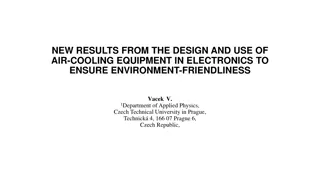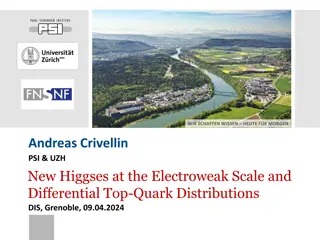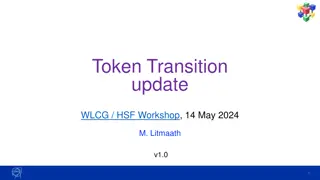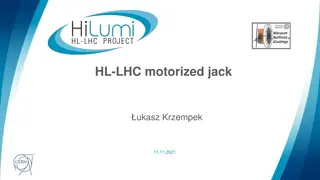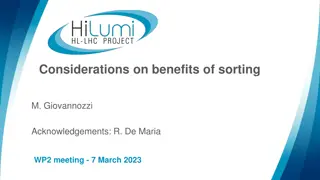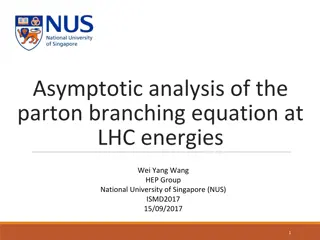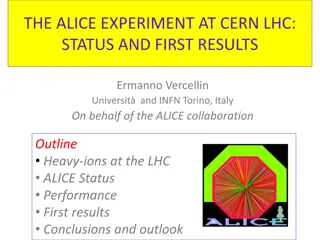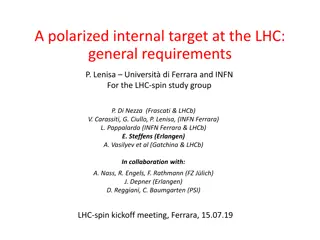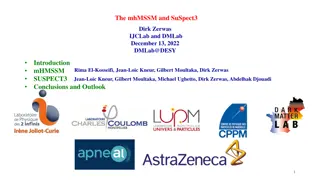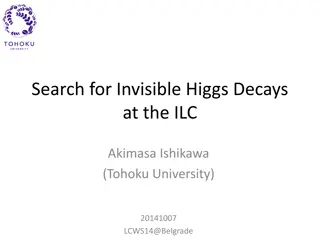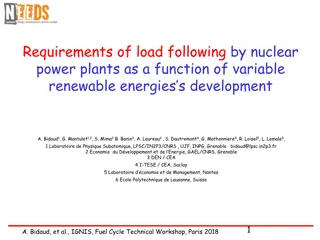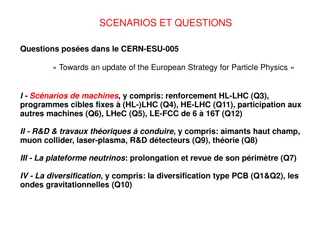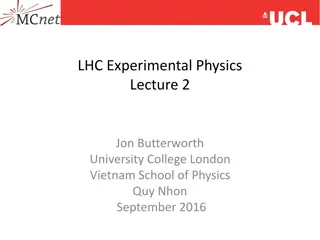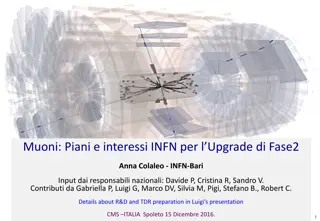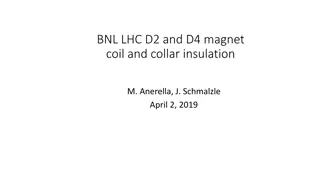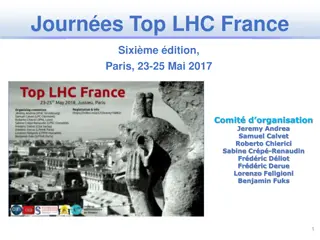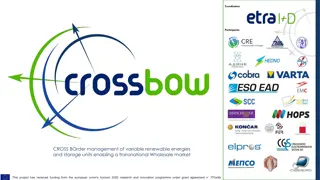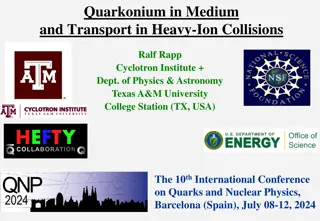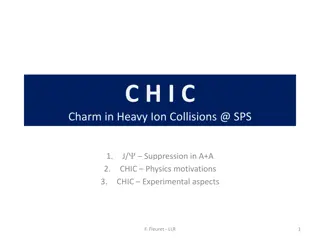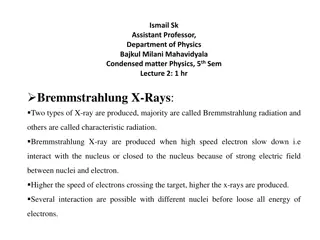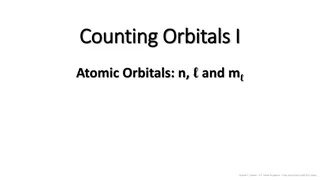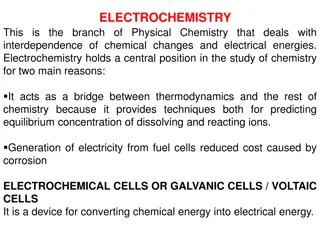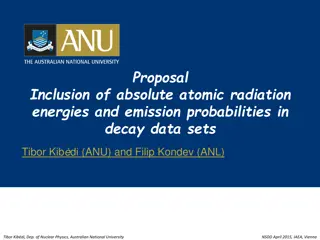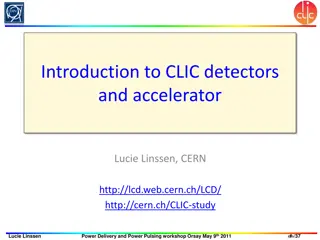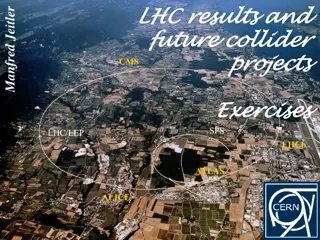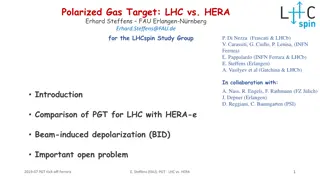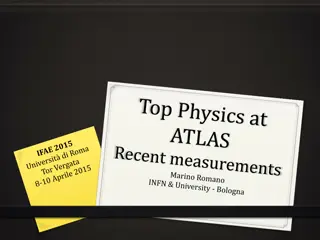FPC & HOM Technology Challenges, FCC
The challenges and technology involved in coupling beam power out of the cavity and coupling RF power into the cavity for the Future Circular Collider (FCC). It also covers the RF layout for the FCC-ee, basic parameters for proton and electron beams, accelerating RF in the LHC, input couplers, and p
0 views • 36 slides
Overview of ALICE Data Acquisition System Upgrade for LHC Run 3
ALICE is undergoing significant upgrades for LHC Run 3, including the implementation of the O2/FLP system. This upgrade will enhance data acquisition, processing, and storage capabilities. Key elements include new computing systems, software, and portfolio enhancements. The project overview outlines
1 views • 23 slides
Multimat-2 Experiment: Advancements in HL-LHC Collimator Technologies
The Multimat-2 experiment conducted by Jorge Guardia Valenzuela and the team at CERN focused on testing prototypes of HL-LHC collimators, including materials and coatings, to improve the robustness and performance under extreme conditions. The goals included deriving strength models, exploring failu
0 views • 13 slides
Innovative Air-Cooling Equipment for Electronics
The design and use of air-cooling equipment in electronics to ensure environmental-friendliness is explored in this study by Vacek V. from Czech Technical University. The equipment is designed to meet demanding requirements for high-tech electronics applications, providing precise temperature regula
0 views • 17 slides
Verification Environment for ALTIROC3 ASIC in ATLAS High Granularity Timing Detector
The verification environment for the ALTIROC3 ASIC in the ATLAS High Granularity Timing Detector is crucial for the upgrades in the ATLAS HL-LHC experiment, aiming to improve particle detection performance in the forward region, mitigate pile-up effects, and provide luminosity measurement. The ALTIR
7 views • 26 slides
New Higgs Bosons and Physics Beyond the Standard Model
Discoveries of new Higgs bosons at the electroweak scale, hints for new scalars at 95 GeV and 151.5 GeV, investigations into the nature of the 151.5 GeV Higgs as a triplet, and analyses of top-quark distributions at the LHC hint at exciting possibilities for physics beyond the Standard Model. ATLAS
0 views • 21 slides
Update on Computing and IAM Service Developments in WLCG/HSF Workshop
Details about the update campaign for HTCondor CEs, APEL support for tokens, and IAM service developments presented at the WLCG/HSF Workshop on May 14, 2024. Highlights include HTCondor CE upgrades, APEL support discussions, and advancements in IAM services for LHC experiments.
0 views • 12 slides
London Homeless Coalition (LHC) Death Communication Protocol
In 2014, the Memorial Committee of the London Homeless Coalition (LHC) established the Death Communication Protocol to acknowledge, share, and address the loss of individuals experiencing homelessness. The protocol aims to inform partnering organizations of confirmed or unconfirmed deaths, support g
0 views • 12 slides
Design Analysis of HL-LHC Motorized Jack Components
This technical document provides detailed information on the design analysis of various components used in the HL-LHC motorized jack system. It includes boundary conditions, material specifications, strength requirements, and stress analysis of components such as push-pull rings, guide cylinders, RA
0 views • 7 slides
Optimizing Benefits Through Sorting in LHC Magnet Systems
LHC's experience highlights the significant advantages of sorting in magnet systems, such as safeguarding against losses in mechanical and dynamic apertures, minimizing beta-beating, and enhancing field quality. By controlling observable quantities like mechanical aperture, transfer function, and fi
0 views • 8 slides
Open Heavy-Flavour Production in pp Collisions at the LHC - Physics Seminar Overview
Physics seminar presentation by Francesco Prino on open heavy-flavour production as a function of multiplicity in pp collisions at the Large Hadron Collider (LHC). The talk covers the motivation behind studying heavy-flavour production mechanisms, data analysis techniques, results on the multiplicit
0 views • 65 slides
Insights into Parton Branching Equation at LHC Energies
Multiplicity distributions play a crucial role in understanding the cascade of quarks and gluons at the LHC energies, revealing underlying correlations in particle production. Popular models like Monte Carlo and statistical models are used to describe the charged particle multiplicity distributions.
1 views • 17 slides
Exploring Heavy-Ion Collisions at CERN LHC: ALICE Experiment Overview
Unveiling insights into heavy-ion collisions at CERN's Large Hadron Collider (LHC) through the ALICE experiment. Delving into the status, performance, and initial results, ALICE aims to characterize the medium formed during collisions. With a collaboration of around 1000 members from 31 countries an
0 views • 29 slides
Understanding and Addressing Instability in Particle Accelerators
In this document, E. Shaposhnikova from CERN discusses observations and cures for instability in particle accelerators. The content covers types of instabilities, observations like direct and indirect effects, and possible cures such as modifying the source, passive and active damping, and changing
2 views • 30 slides
Study of a Polarized Internal Target at the LHC: General Requirements and Preliminary Results
The LHCb Spectrometer at the Large Hadron Collider is exploring the design of a polarized gas target (PGT) similar to the HERMES target in the VELO alcove. The project aims to improve precision in luminosity measurements for antiproton production in colliding bunches. The new SMOG2 system with addit
0 views • 21 slides
Exploring the mhMSSM and SuSpect3 in Particle Physics
Explore the history and significance of the mhMSSM and SuSpect3 in particle physics, including the development of the MSSM, pMSSM, SuSpect calculator, and key discoveries like the R=+1 particle and relic density studies. Learn about supersymmetric particles, models like mSUGRA and NMSSM, and implica
0 views • 17 slides
Understanding Electronic Excitation in Semiconductor Nanoparticles from a Real-Space Quasiparticle Perspective
This research delves into the electronic excitation in semiconductor nanoparticles, focusing on real-space quasiparticle perspectives. It explores treating electron correlation using explicit operators, leading to faster algorithms while calculating optical gap and exciton binding energies. Various
0 views • 45 slides
Exploring Invisible Higgs Decays: Insights from ILC and LHC
Investigating invisible Higgs decays plays a crucial role in unveiling potential signals of new physics, like Dark Sectors or Dark Matter. The search for invisible Higgs decays at the International Linear Collider (ILC) and the Large Hadron Collider (LHC) involves unique techniques such as recoil ma
0 views • 18 slides
Key Fusion Reactions in Nuclear Astrophysics
Fusion reactions play a crucial role in nuclear astrophysics, with key reactions involving light elements such as Li, Be, B, and stable carbon isotopes. Understanding fusion of light heavy nuclei at extreme energies is essential for predicting stellar evolution. The S-factor provides a convenient re
0 views • 31 slides
Load Following by Nuclear Power Plants in Relation to Variable Renewable Energies' Development
The study explores the requirements of load following by nuclear power plants in the context of variable renewable energies' growth. It discusses the impact of renewable energy development on nuclear economic models and the need for dispatchable capacities. Benchmarks are set to test robustness of d
0 views • 11 slides
Update of European Strategy for Particle Physics: Scenarios and Questions
Briefing book by CERN's Physics Preparatory Group outlines the landscape of particle physics field and proposes five scenarios for future major colliders in Europe, including HL-LHC, CLIC, FCC, LHeC, and LE-to-HE-FCC-h/e/A. The book emphasizes the need for technology decisions and investments to rea
0 views • 6 slides
Insights into LHC Experimental Physics: Lecture Highlights and Challenges
Delve into the world of experimental physics at LHC with lectures by Jon Butterworth at University College London in September 2016. Topics covered include accelerators, detectors, principles, and digressions, along with discussions on triggers, multi-level trigger systems, and collision selection m
0 views • 26 slides
Muon Phase2 Upgrade: INFN Collaboration for Detector Enhancement
The Muon Phase 2 upgrade project aims to improve the performance of muon detectors for the HL-LHC conditions. Collaborating with INFN, the project focuses on maintaining excellent triggering and measurement capabilities under harsher conditions. Key aspects include existing detector consolidation, n
0 views • 17 slides
HiLumi-LHC MQXF Conceptual Specifications and Requirements Overview
The HiLumi-LHC project collaborated with various institutions to develop conceptual specifications and requirements for the MQXF, with contributions from experts in the field. The project focused on design study and received funding from the European Commission and the US LHC Accelerator Research Pr
0 views • 11 slides
BNL LHC D2 and D4 Magnet Coil and Collar Insulation Details
Coil insulation includes 5 mil Kapton caps and b-staged adhesive on the pole and midplane. Quench resistor insulation comprises 1 mil Kapton and adhesive. Collar insulation consists of 2 x 5 mil Kapton caps. Cable insulation layers and materials between coil and heater, and heater and collar, are de
0 views • 5 slides
Insights into Top LHC France: Past, Present, and Future
Delve into the history and evolution of Top LHC France through its past editions, discussing topics, participation trends, and the upcoming 2018 event. Learn about the focus on top physics, collaboration opportunities, and the importance of participant feedback. Explore the connection between the HE
0 views • 6 slides
Cross-Border Management of Variable Renewable Energies and Storage Units
This EU-funded project, CROSSBOW, addresses industrial challenges and standards needs for managing variable renewable energies and storage units. It focuses on system integration with smart transmission grids and storage technologies to increase renewables' share. The project tackles four major inno
0 views • 11 slides
Quarkonium in Medium and Transport in Heavy-Ion Collisions
Discussing the properties and behavior of quarkonium in medium and its transport in heavy-ion collisions. Topics include heavy-quark potential, confinement, quarkonia at finite temperature, quarkonium transport, and quarkonia in heavy-ion collisions. Insightful details about in-medium potential and
0 views • 30 slides
Charm in Heavy Ion Collisions: Experimental Comparisons from SPS to LHC
Investigating charm suppression in heavy ion collisions at different energy levels, this study compares experimental data from SPS to LHC. Analysis suggests similar suppression at SPS and RHIC, with potential factors like recombination and direct J/ψ production influencing results. Uncertainties re
0 views • 16 slides
Understanding Bremmstrahlung and Characteristic X-Rays in Condensed Matter Physics
In condensed matter physics, Bremmstrahlung X-rays and characteristic X-rays are produced through different interactions of high-speed electrons with nuclei in target atoms. Bremmstrahlung radiation is generated when electrons slow down near the nucleus, while characteristic radiation is produced wh
0 views • 5 slides
Experimental Setup at IP5 for Inelastic Events and Particle Detection
Experimental setup at IP5 involves inelastic telescopes for charged particle detection and vertex reconstruction. The setup includes T1 and T2 telescopes, HF and CASTOR detectors, as well as Roman Pots for measuring elastic and diffractive protons. The TOTEM experiment focuses on proton-proton inter
0 views • 27 slides
Understanding Atomic Orbitals: Counting, Subshells, Energies, and Electrons
Learn about the basics of atomic orbitals, including the counting of orbitals in shells and subshells, the distribution of electrons in different energy levels, and the symmetrical nature of orbital labeling. Dive into the rules governing electron placement based on quantum mechanics and explore the
0 views • 6 slides
Understanding Electrochemistry: The Interplay of Chemical Changes and Electrical Energies
Electrochemistry, a branch of Physical Chemistry, explores the relationship between chemical reactions and electrical energies. It serves as a vital link between thermodynamics and other areas of chemistry, offering insights into equilibrium concentrations and facilitating the generation of electric
0 views • 24 slides
Integration of Atomic Radiation Energies and Emission Probabilities in Decay Data Sets
Proposal by Tibor Kibdi and Filip Kondev to include absolute atomic radiation energies and emission probabilities in decay data sets. They emphasize the need for energy and intensity data to be computer-readable and use standard notation. The inclusion of atomic relaxation data into ENSDF is discuss
0 views • 7 slides
Insights into Particle Ratios and Equilibrium Dynamics at LHC
Collection of observations from LHC data regarding particle ratios and the successful Thermal Model. Discusses the concept of equilibrium, onset of equilibrium, relationship to QGP phase, and potential solutions through out-of-equilibrium studies. Also delves into size/volume dependence, strangeness
0 views • 11 slides
Overview of CLIC Detectors and Accelerator Studies
CLIC detectors and accelerator studies aim to explore new physics beyond the current energy scales reached by the LHC. The CLIC project focuses on a linear collider for e+e- collisions, with an energy reach up to 3 TeV. The two-beam scheme, detector concepts, challenges, and comparison to the LHC ar
0 views • 59 slides
Project Review and Recommendations for HL-LHC AUP IPR DOE/SC Review
Summary of project reviews and recommendations for the High-Luminosity Large Hadron Collider (HL-LHC) Accelerator Upgrade Project (AUP) during the DOE/SC Review in January 2020. Covers technical progress, schedule management, external dependencies, and procurement management. Emphasis on project com
0 views • 10 slides
Unraveling Collider Physics: Investigations, Interpretations, and Accelerations
Dive into the world of collider physics with a focus on LHC results, future collider projects, and experiments from the Baikal Summer School 2021. Explore topics like invariant mass calculations, Higgs boson decays, particle acceleration in the LHC tunnel, and particle velocity considerations. Engag
0 views • 10 slides
Comparing Polarized Gas Targets at LHC and HERA for Spin Studies
The comparison between Polarized Gas Targets (PGT) at the Large Hadron Collider (LHC) and HERA for spin studies is discussed. Key considerations such as beam-induced depolarization, beam parameters, and design aspects are highlighted. The importance of using a polarized gas target similar to HERMES
0 views • 15 slides
Latest Updates on Top Quark Physics at ATLAS
Re(comissioning of LHC and ATLAS has begun with the recording of the first beam splash events. Exciting developments in top quark physics include measurements of top pair production, decays, and inclusive cross sections at different energies. The studies aim to test the Standard Model, observe new p
0 views • 37 slides



